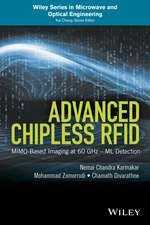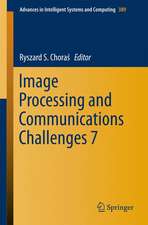Multiresonator-Based Chipless RFID: Barcode of the Future
Autor Stevan Preradovic, Nemai Chandra Karmakaren Limba Engleză Paperback – 3 mar 2014
| Toate formatele și edițiile | Preț | Express |
|---|---|---|
| Paperback (1) | 637.59 lei 6-8 săpt. | |
| Springer – 3 mar 2014 | 637.59 lei 6-8 săpt. | |
| Hardback (1) | 641.53 lei 6-8 săpt. | |
| Springer – 26 dec 2011 | 641.53 lei 6-8 săpt. |
Preț: 637.59 lei
Preț vechi: 750.11 lei
-15% Nou
Puncte Express: 956
Preț estimativ în valută:
121.100€ • 127.38$ • 100.97£
121.100€ • 127.38$ • 100.97£
Carte tipărită la comandă
Livrare economică 05-19 aprilie
Preluare comenzi: 021 569.72.76
Specificații
ISBN-13: 9781489991171
ISBN-10: 1489991174
Pagini: 192
Ilustrații: XX, 172 p.
Dimensiuni: 155 x 235 x 10 mm
Greutate: 0.34 kg
Ediția:2012
Editura: Springer
Colecția Springer
Locul publicării:New York, NY, United States
ISBN-10: 1489991174
Pagini: 192
Ilustrații: XX, 172 p.
Dimensiuni: 155 x 235 x 10 mm
Greutate: 0.34 kg
Ediția:2012
Editura: Springer
Colecția Springer
Locul publicării:New York, NY, United States
Public țintă
ResearchCuprins
Low Cost Chipless RFID Systems.- Spiral Resonators.- Ultra Wideband Antennas.- Chipless RFID Tag.- Transceiver Design for RFID Tag Reader.- Chipless RFID Tag-Reader System.- Conclusions and Future Works.
Notă biografică
Dr. Preradovic is a Design Engineer for Nitero and serves as an Adjunct Research Associate at Monash University.
Textul de pe ultima copertă
This vital new resource offers engineers and researchers a window on important new technology that will supersede the barcode and is destined to change the face of logistics and product data handling. In the last two decades, radio-frequency identification has grown fast, with accelerated take-up of RFID into the mainstream through its adoption by key users such as Wal-Mart, K-Mart and the US Department of Defense. RFID has many potential applications due to its flexibility, capability to operate out of line of sight, and its high data-carrying capacity. Yet despite optimistic projections of a market worth $25 billion by 2018, potential users are concerned about costs and investment returns. Clearly demonstrating the need for a fully printable chipless RFID tag as well as a powerful and efficient reader to assimilate the tag’s data, this book moves on to describe both. Introducing the general concepts in the field including technical data, it then describes how a chipless RFID tag can be made using a planar disc-loaded monopole antenna and an asymmetrical coupled spiral multi-resonator. The tag encodes data via the “spectral signature” technique and is now in its third-generation version with an ultra-wide band (UWB) reader operating at between 5 and 10.7GHz.
Caracteristici
Focuses on chipless RFID and the detailed design of a chipless RFID system with a comprehensive overview of other chipless RFID systems as well Discusses the multiresonator based chipless RFID system which was developed and patented for anti-counterfeiting applications Examines RFID technology that is on the market but also prototyped by research institutions around the world Includes supplementary material: sn.pub/extras

























